F**king Delicious, Fizi, Petarda or Sens? Different Worlds of Protein Bars

Are most protein bars still muscle-centric? Or have they long ceased to be aimed solely at muscular and strong guys? Find out what customers expect from protein bars.
Background
Our appetite for snacks is growing – whether it’s to quickly and conveniently satisfy a small hunger or to provide comfort. There’s no denying that the pandemic has left consumers feeling helpless, which may have further increased their demand for healthy snacks. Let’s take a look at semiotic analyzes.
This trend is further strengthened by the prevalence of a sedentary and intense lifestyle and the growing demand for convenient food.
Healthy eating has become one of the main trends – most consumers expect food and beverages to meet increasing health expectations.
Vantage research predicts that by 2028 the protein bar market will reach a value of $6 billion, with the plant-based category accounting for over 30% of total sales by that year (source: https://tiny.pl/dxbzj).
At the same time, it’s worth remembering that the global nutritional bar market is also driven by the growing demand for confectionery, making taste an important factor when choosing a product. While we have become greater proponents of healthy alternatives, it’s certainly not at any cost.
Protein Bars, What Are They?
Typically, protein bars are classified by the amount of protein they contain. The average protein bar contains between 16 and 25 grams of protein. This means protein bars are characterized by relatively high-protein content and sometimes relatively low carbohydrate content.
However, manufacturers are increasingly experimenting, as ordinary protein bars seem insufficient for the modern consumer, who is increasingly considered a superhuman. There’s no denying – functional products will only continue to gain popularity.
And For Whom?
Whether you’re a fitness enthusiast, a health-conscious individual, or simply looking for a convenient and filling snack – the protein bar category now has something for everyone.
So, What Do We Expect From Protein Bars?
First and foremost, specific ingredients – reduced fat, salt, sugar, but also (and perhaps most importantly) appropriate nutritional values, such as proteins or specific macronutrients. Occasionally, what’s absent is more important than what’s present. It’s undeniable that the rising star in the realm of functional ingredients is protein. When you lack time, it can be an ideal solution that aids muscle recovery and staves off hunger.
Ensuring an adequate protein intake has become synonymous with taking care of one’s health “here and now” – because regardless of where you are, you can always reach for a protein bar that does its job. And it’s not just about the muscle-bound gym-goers talking primarily about the gym. Research shows that consuming large amounts of protein improves the quality of skin, hair, and nails.
However, this doesn’t mean we forget about taste and pleasure – these are still key factors influencing the purchase of almost all food products. Therefore, when building loyalty to a brand and its products, we must not forget this.
Trends in the Protein Bar Market
- Creating innovative flavour combinations and variants: Combining diverse ingredients from around the world.
- Innovations in product composition: Introducing organic, vegan, and other products to the market.
- New sources of protein: In 2024, we can expect protein bars based on alternative protein sources, such as algae.
- Personalization: Recommending personalized formulas of protein bars based on goals, dietary restrictions, and consumer health profiles.
- Inspiration from the wellness segment: The emergence of new products with additional benefits such as mood enhancement, immune support, or improved sleep quality.
- Naturalness: Producers will prioritize using whole, natural ingredients and avoiding artificial additives, sweeteners, and preservatives. This is to achieve the taste and appearance that consumers seek. Freeze-dried ingredients can help achieve this goal as they are healthy, natural, flavourful, and, most importantly, recognizable.
- Transparency: Increasingly, entities indicate exactly what’s in their products. Consumers, as they become more health-conscious, are much less satisfied with terms like “sugar-free” expecting precise information about the composition.
How to Meet the New Consumer Requirements
Changing consumer preferences are changing as quickly as they are, which means that in February we are avid runners, and in March, when asked about our favourite form of activity, we will only mention yoga and long walks.
At the same time, engagement and awareness levels are increasing, and purchases are increasingly made based on dietary restrictions, the growing number of which, ingredient considerations, or environmental concerns.
Ensuring transparent labels will become increasingly important for modern consumers. It’s not just about not feeling cheated. More and more, they want the producer to provide clear access to the most significant product information.
Over half of buyers check the sugar content, and 93% of those interested in lower sugar options from their favourite brands of bars. Additionally, some of the most essential ingredients consumers want to read about are usually salt and fats, along with the nutritional value of the product. In the case of functional products (e.g., protein bars), additional ingredients (e.g., protein, fibre) will be significant.
Protein Bars and the Store Shelf
It can be assumed that the most protein bars are sold around noon, confirming they are consumed as or in place of lunch. As for what might end up in the basket with them, it’s energy drinks, other bars, and still bottled water.
If a store serves people on the go – commuting to work and those going for a quick lunch or afternoon snack – it’s worth checking if these products are close to each other. Most often, protein bars will end up at the entrance, at the checkout, or in designated functional food aisles.
Categorizing Protein Bar Packaging
The global segmentation of the protein bar market divides them by source (plant-based and animal-based) and by type (energy bars, high-protein bars, meal replacement bars, low-carb bars, and others).
However, given the growing competition in the global market, one strategy for building an advantage might be to focus on packaging that addresses specific motivations, so let’s focus on that.
Protein Bars No Longer Just for Muscles
The visual world of protein bars is no longer limited to elements symbolizing protein, sugar, or fibre content. Increasingly, it also includes elements belonging to the world of success – strength and autonomy.
On the store shelf, we are increasingly likely to see, besides flowing caramel or freeze-dried raspberries’ visualization, a picture of Ewa Chodakowska bending or Ania Lewandowska’s flamboyant signature.
The protein bar category is no longer muscle-centric. The proof of this is the various visual worlds aimed at reaching slightly different target groups.
Category 1: Nutritional
Containing high amounts of protein and fibre that help you feel fuller for longer, as well as other vitamins and minerals providing well-balanced nutrition. It’s not just a snack but primarily a source of energy and nutrients.

- Target group: Active people, those on a reduction diet, or those wanting to improve their muscle mass. All calorie counters who might find themselves needing to top up their protein at the end of the day.
- Motivation: Consumed before or after training, providing steady energy during exercise or a series of benefits after completing it.
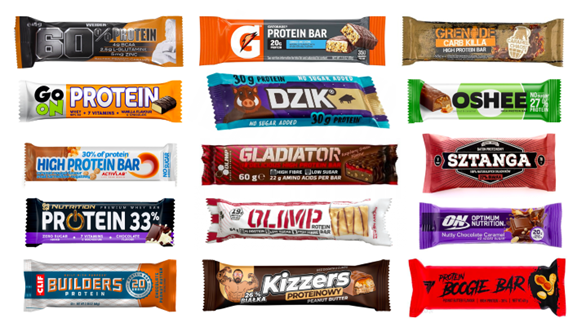
- Visual world: Here, quantity matters, so numbers and everything expressed in percentages – percentage figures or protein grams (e.g., 60% Protein, 30g) directly communicating the high-protein content, which is the main asset of these products. The dominant colours are red and orange, suggesting energy and dynamism, which (as we know) every true muscle needs. Graphic elements related to strength and sports, such as silhouettes of athletes or musculature, proposing the product is intended for physically active people and those building muscle mass. Broad, predominantly sans-serif fonts give an impression of power and solidity.
Category 2: Tasty
Functioning primarily as a sweet dessert.
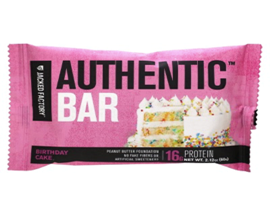
- Target group: For everyone who believes health shouldn’t mean compromise. Healthy snacks are a choice, but they must be easy choices that still ensure taste, fun, and pleasure. Nutritious must be delicious.
- Motivation: Wanting to eat sweets without guilt.
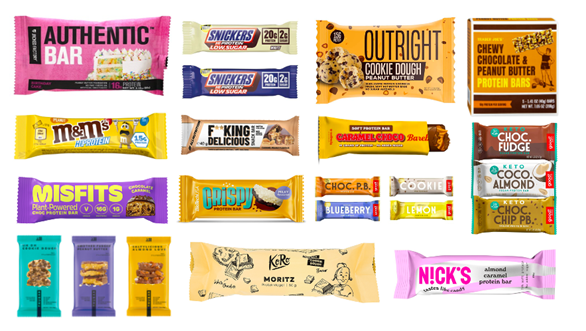
- Visual world: Visible ingredients such as pieces of chocolate, nuts, but also visualizations of desserts that inspire the product’s flavour, thus directly referring to the product’s tastiness. The dominant colours are yellow and orange – these colours are associated with joy and energy. On the other hand, pink and purple are colours that stand out effectively and may suggest the product’s uniqueness or innovation. Information about the low sugar content in this case proposes the product is a healthier alternative to traditional sweets. Stylized fonts and dynamic graphic layouts give the products a modern look, thus attracting younger consumers.
Category 3: Transparent
Simple ingredients, clear composition – bars that don’t want to surprise us with anything.
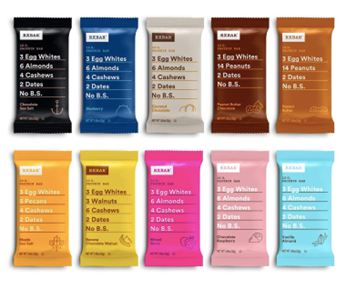
- Target group: Conscious and uncompromising about chosen food products, while being highly cost-aware.
- Motivation: Seeking whole ingredients. Aware that many protein bars consist of highly processed ingredients and artificial additives.
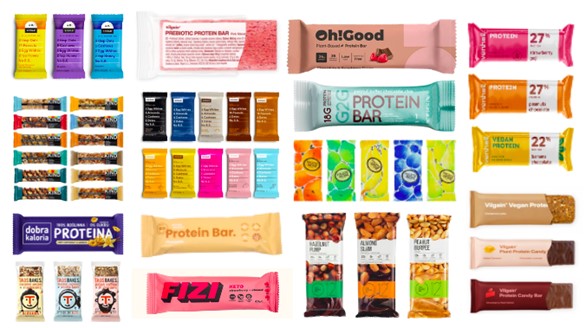
- Visual world: Minimalist and clear designs give an impression of modernity and simplicity. A clear label is also one of the indicators of the product’s credibility. The use of simple, sans-serif fonts only reinforces the impression of honesty. Additionally, in this category, there are transparent packages, allowing the consumer to know exactly what they are picking when buying the product.
Category 4: Natural
- Target group: For everyone who cares about the naturalness of products.
- Motivation: Paying attention to the origin of the products themselves and the ingredients they consist of.
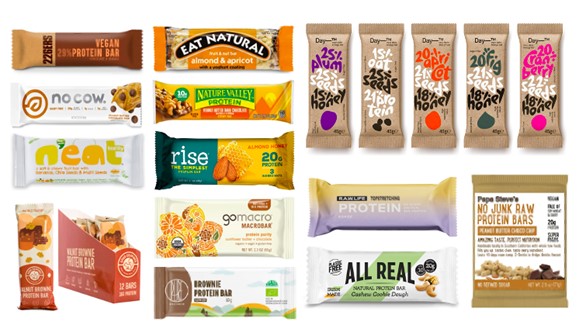
- Visual world: Packaging with simple patterns (e.g., packages with leaf or nature motifs) emphasizes the naturalness of the products. In this category, mentions of ingredients of natural origin are also important, highlighting the product’s suitability for vegans and those following a plant-based diet.
There’s More
Of course, these aren’t all the categories available on the market, but they certainly have the largest representation. This means that other areas constitute a market niche that will likely be consistently filled over the coming months (or years).
Categories Don’t Operate in a Vacuum
It’s worth emphasizing that not all products belong to just one category. Some use the codes of many subcategories (which then mix) probably to avoid narrowing their target group.
There are, of course, so-called splits, where the manufacturer or someone responsible for packaging tries to cater to more than one consumer need – whether in the form of a limited edition or a product that talks about both taste and functional ingredients.
The result is products like Grenade’s “birthday cake” or “oreo” flavours.
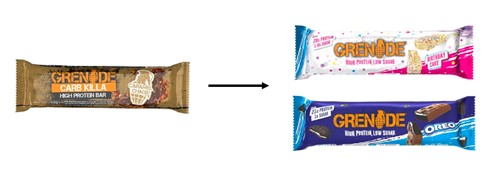
The Confectionery Category and the Functional Products Category
It’s worth noting that as the health movement progresses, the confectionery category will be subject to more regulations on what can be promoted and what cannot.
Protein bars that manage to meet consumer expectations regarding texture and taste may soon become a worthy alternative to so-called impulse wafers, or perhaps they already are?
What to Remember
- Try to understand the category;
- Analyse the conventions and codes operating within it;
- Don’t limit yourself to safe measures, as they are likely to go unnoticed;
- Have fun with it (as much as possible);
- Protein bars belong to the category of impulse products, so they primarily need to catch our attention for the mentioned impulse to even work.
*Not all packages included in the comparison are market products. I also decided to show those found on packagingoftheworld.com because some are perfect solutions for the described convention (e.g., Fruits&More).
**If you liked the analysis and are currently designing packaging for a product in this category (or another), contact us at m.picheta@stratosfera.com – we can help.
[1] RESEARCH